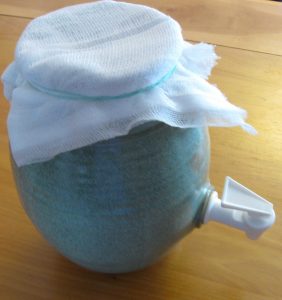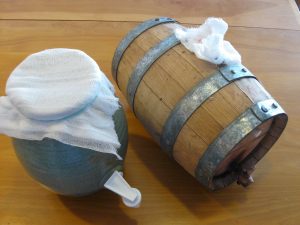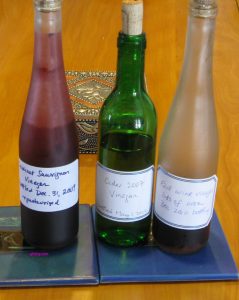Homemade vinegar is easy to make – it kind of makes itself under the right conditions – and we have been making our own for 25 years. The vinegar you buy in the grocery store (white, cider, wine) is sharp tasting and thin in flavor compared to the rich complexity of a homemade vinegar. Make your own vinegar and you will become a fan! Also, with your own homemade vinegar there is no need to read labels looking for gluten-containing items. The test of a delicious vinegar is this: sip up a teaspoon of the vinegar and you should want more! You will not want to waste this homemade vinegar making those baking soda and vinegar volcanoes that are so popular in elementary and middle school classes.
You will need:
- Leftover Wine diluted with unchlorinated water
- Vinegar culture (a bacterial culture, check with the manufacturer and do NOT use malt vinegar culture)
- a wide-mouthed glass or stoneware container
- Cheesecloth to keep fruit flies out of the vinegar while allowing air to enter the container
- Room temperature (68-96 degrees)
- surgical hemostat clamp (a ten dollar item) for easily removing old vinegar mother
If you really get in to making homemade vinegar, you may want to invest in a handy vinegar crock with a spigot, or an oak vinegar barrel. Bear in mind that it is not safe to use homemade vinegar in home canning or pickling, unless you are a talented chemist who can accurately test the acidity of your finished product. For pickling, you need 5% acidity.

To make Vinegar:
Choose what kind of vinegar you are making: red, white, cider. Dilute leftover wine or hard cider with unchlorinated water, about 2 parts of wine to one part of water. Put about a quart of diluted wine in to a cleaned large mouth jar or bowl, or vinegar crock. We use C-brite to clean the container. Add the starter culture. Stir with a clean spoon; cover the container with cheesecloth secured with a rubber band (keeps out fruit flies while allowing air to enter). Store the crock at the back of the counter in your kitchen, where the vinegar will remain largely in the dark and at 68-96 degrees. In about 4 weeks the first vinegar should be ready to use in salad dressings and sauces. Pour off some of the vinegar, taste it and dilute it with additional water if it tastes too strong, then bottle it in sterilized bottles and cork the bottles.
Now add more diluted wine to your crock – this is called “feeding” your vinegar and let it go. Each time you get ready to bottle some vinegar, taste the finished product to see if it is ready for bottling, and add water if the flavor is too strong. Since this is a trial-and-error, imprecise method for achieving the final product, you will not know the final Ph of the homemade vinegar and cannot use this vinegar to make pickles or preserves that are not refrigerated.
Vinegar Culture:
To make vinegar, you add a starter culture of acetic acid bacteria to an alcohol base (like wine or hard cider). For the starter culture, you can use some vinegar from a friend’s vinegar crock, or you can buy a culture. For gluten free vinegar, do not use malt vinegar culture.
Vinegar Mother:
Vinegar mother is a thick cellulose material created by the vinegar bacteria. People who have never handled vinegar mother call it “slimy” but that is not a good description. The material is strong, thick and fibrous, stretchy, slippery and somewhat leathery – like the covering on a papaya seed, or a sort of fibrous jelly. It can break cleanly in to clumps when you pull on it. The mother accumulates in your crock or barrel, and eventually some of it needs to be removed to make room for more wine. The mother is not necessary to the formation of new vinegar – what you need is the bacteria. So, if you have a friend who makes good vinegar and does not pasteurize it, ask for a sample of their vinegar and you are ready to go.
Vinegar Barrels:
A word about vinegar barrels – the oak vinegar barrel adds a strong oak flavor to a red wine vinegar, and we use one for this purpose. However, the home vinegar maker should be forewarned about a couple of things. 1) The vinegar barrel should be soaked before using, to prevent leaking. 2) Unless the barrel has a large opening at one end, removing old vinegar mother from your vinegar barrel requires two people, because most of these barrels only have small holes through which to remove the mother. One person holds the barrel so that a hole is facing downwards (the largest hole is the air hole at the top) and the other person uses a surgical hemostat clamp to grab bits of the mother and pull them through the hole. This is a messy process.

Bottling:
We bottle the vinegar without pasteurizing it.
Homemade Vinegar and Pickling:
- Do not use homemade vinegar for making pickles. Vinegar used in pickling must be of a certain Ph, or you can have spoilage and dangerous bacteria can grow in the pickles.
More Instructions:
Further instructions for making your own vinegar are available here: http://www.claycoyote.com/blog//SunsetMagazine_Vinegar.pdf
0

A great recipe, well detailed and clearly written.
Thank you